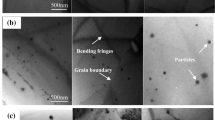Conclusions
-
1.
Tensile strength tests at different temperatures of smooth and notched samples with given strength and ductile characteristics do not reveal the critical embrittlement temperature of vanadium.
Static and impact bending tests made it possible to determine the susceptibility to brittle fracture of vanadium of differing purity.
-
2.
Interstitial impurities (nitrogen and oxygen) substantially increase the strength and lower the ductility. Substitution impurities (aluminum, silicon, and iron) have less effect on these characteristics.
-
3.
Interstitial impurities raise the cold-brittleness threshold. A change in the concentration of these elements by only 0.3 at. % raises the cold-brittleness threshold more than 200\dgC.
-
4.
The impact toughness of vanadium of differing purity in the completely ductile condition (i.e., above the cold-brittleness threshold) is almost identical. The difference in the impact toughness of vanadium is due mainly to the difference in the values of the cold-brittleness threshold.
-
5.
The cold-brittleness threshold determined from static bending tests is 40\2-50\dgC below that determined from impact tests.
Similar content being viewed by others
Literature cited
A. Eustice et al., Trans. AIME,221, No. 2 (1961).
G. Hahn et al., "The effect of solutes on the ductile-to-brittle transition in refractory metals," Proceedings of the April 15, 1961, Refractory Metals Symposium, Chicago.
Q. Mtthews et al., Report of Investigations 6637 (1965), US Dept. of the Interior, Bureau of Mines, Washington D. C.
B. Loomis and O. Carlson, Reactive Metals, Interscience Publishers, New York-London (1959).
E. M. Savitskii et al., in: Investigation of Alloys of Nonferrous Metals [in Russian], Vol. 2, Izd. AN SSSR, Moscow (1960).
R. Thompson and O. Carlson, Journal of Less-Common Metals,9, No. 5 (1965).
W. Clough and A. Pavlovic, Trans. Am. Soc. Met.,52 (1960).
N. A. Shaposhnikov, Mechanical Testing of Metals [in Russian], Mashgiz, Moscow (1954).
H. Neiber, Stress Concentrations [Russian translation], OGIZ (1947).
B. A. Drozdovskii and Ya. B. Fridman, Effect of Cracks on the Mechanical Properites of Structural Steels [in Russian], Metallurgizdat, Moscow (1960).
U. Rostoker, Metallurgy of Vanadium [Russian translation], IL, Moscow (1959).
Additional information
State Rare Metals Research Institute, Moscow Institute of Chemical Machine Construction. Translated from Metallovedenie i Termicheskaya Obrabotka Metallov, No. 1, pp. 56–62, January, 1970.
Rights and permissions
About this article
Cite this article
Vorob'eva, L.P., Gulyaev, A.P. & Druzhinina, I.P. Mechanical properties and cold-brittleness threshold of vanadium. Met Sci Heat Treat 12, 53–58 (1970). https://doi.org/10.1007/BF00651715
Issue Date:
DOI: https://doi.org/10.1007/BF00651715




